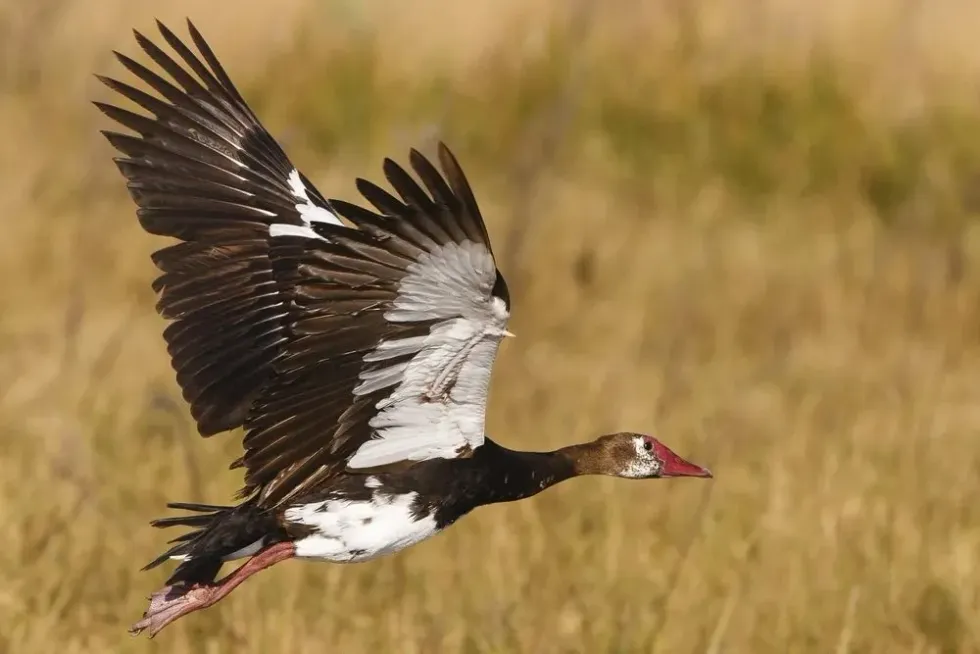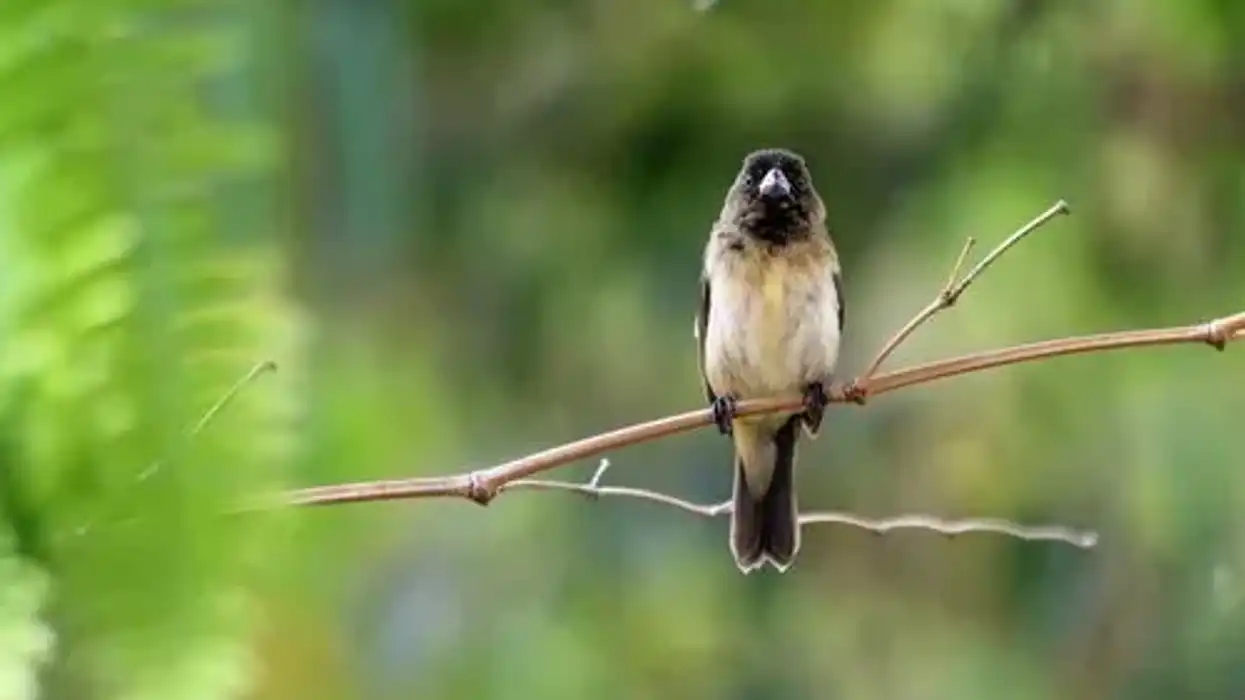The spur-winged goose Plectropterus gambensis (of the Anatidae family) is a remarkably interesting bird. It is called a goose because of its large size and nesting habits, but it is, in fact, a type of duck classified under the group of 'True Ducks.'
Because it shares some geese and duck features while being its own creature, it is slotted in its own subfamily Plectropterinae. The genus of the spur-winged goose plectropterus comes from the Greek word for a ‘cock’s spur.'
This is a reference to the spurs on their wings, which the males use to fight each other for the right to mate during the breeding season. Females have spurs as well, but they are smaller and not as sharp as the males’ spurs.
These spurs are very sharp and can be poisonous.
The blister beetles that the spur-winged goose loves to eat are very poisonous. This poison is stored by the geese in their bodies.
This means that spur-winged goose meat can kill people who eat it. The poison is also stored in their wing spurs, making them that much deadlier.
You may also check out the fact files on the kea parrot and American kestrel from Kidadl.
Spur-winged Goose Interesting Facts
What type of animal is a spur-winged goose?
Despite its name, the spur-winged goose is more closely related to the duck family known as ‘true ducks’ rather than geese.
What class of animal does a spur-winged goose belong to?
The spur-winged goose Plectropterus gambensis is a species of bird of the family Anatidae, subfamily Plectropterinae. Just like ducks, they are a type of waterfowl. This means they can swim; their feathers are waterproof, and they have webbed feet.
How many spur-winged geese are there in the world?
The population size of the spur-winged geese in the world is stable for now, and there are a large number of these geese alive today. The conservation status of this species is ‘Least Concern,’ which means that the number of individuals is more than 10,000.
This is why spur-winged goose zoos do not exist. Most of these birds are found in the wild.
Where does a spur-winged goose live?
The spur-winged goose Plectropterus gambensis lives primarily in wetlands in Sub-Saharan Africa.
What is a spur-winged goose's habitat?
As waterfowl, the spur-winged goose is a species of the family Anatidae that lives in wetlands or grasslands that are rich in water sources like lakes and rivers. They prefer freshwater rather than saltwater. They live in around 35-37 countries in the African continent, including Zambia, Zimbabwe, and South Africa.
Who do spur-winged geese live with?
The spur-winged geese tend to stick to themselves in flocks of about 50 individuals.
How long does a spur-winged goose live?
A healthy spur-winged goose can live up to 11 years in captivity.
How do they reproduce?
During the breeding season, the spur-winged geese get very grumpy and pick fights with each other as well as other birds. This goose, the spur-winged, causes a lot of damage by hitting other geese or waterfowl with its wings, causing a lot of damage with its sharp, deadly spurs.
The breeding season varies across the continent. In North Africa, it is from August to December.
In East Africa, the breeding season is around February to July, whereas in Southern Africa, it is between January to May. The females lay about 7-12 eggs. The spur-winged goose eggs need to be incubated for around 30 days.
Males hang around to protect the nest and their families during this time. Rarely do they hang around after the eggs have hatched while the females rear the baby birds.
What is their conservation status?
According to the IUCN, the conservation status of the spur-winged goose Plectropterus gambensis is Least Concern. Their populations remain steady despite hunting by human beings and steady, ongoing loss of habitat.
Spur-winged Goose Fun Facts
What do spur-winged geese look like?
Spur-winged geese are mostly black and white birds with brownish feathers on top, which shimmer in the sunlight. They have pale grayish faces and red beaks. They might also have white patches on their faces but usually, always have white patches on their wings.
The primarily black spur-winged goose is a smaller sub-species. In male spur-winged geese, the red extends as a patch onto the face. They also have a red knob where the beak begins.
Female geese might also have this knob, but it is usually not noticeable. This knob grows as the bird grows older. They have long reddish legs and are unusually large, which makes them distinct among the waterfowl in their regions.
Both male and female spur-winged geese have spurs on the wings, which is a bony extension on the wing. The female spur-winged goose spur is smaller.
These are sharp and sometimes poisonous. The geese use these when they fight with each other or even other birds. Their wingspan of 59-79 in (150-200 cm) with spurs on wings make them so fast.

How cute are they?
Being very large, aggressive birds, with plain black and white coloring and odd red knobs on their faces, the spur-winged geese are not considered the cutest of birds. The spur-winged goose spur also makes them dangerous rather than cute. However, the spur-winged goose baby is fuzzy and looks like a regular duckling and is quite adorable.
How do they communicate?
The African spur-winged goose of the subfamily Plectropterinae is a typically quiet species of bird. The females hardly make any sounds, while the males may make soft whistles or warbles when flying. They do make some gentle, non-distinct sounds if alarmed. They might also make some sounds at each other when fighting during the breeding season.
Most of the communication among this bird species is through body language. The most distinct is the threats displayed by the males during the breeding season. In this time, males start fights by extending and opening their wings.
On the spur-winged goose, the spur on both their wings is very sharp and poisonous. They are visible when the wings are open. This is called a threat display because the male birds are showing off how strong they are to each other before they actually fight.
How big is a spur-winged goose?
A spur-winged goose is a rather large bird. In fact, it is the largest of the African waterfowl.
This species is actually more closely related to the duck family, but it is called a goose because of its size. The spur-winged goose range of length is between 30-40 in (76.2-101.6cm). In comparison, the average duck is about 19-25 in (48.2-63.4 cm) long, which makes the spur-winged goose 1.5 times larger.
How fast can a spur-winged goose fly?
The spur-winged goose Plectropterus gambensis is an incredibly fast species, among the same category as the red-tailed hawk, which flies at 121 mph (194.7 kph), or frigate birds, which fly at 95 mph (153 kph). The spur-winged goose speed is around 88 mph (142 kph).
In contrast, the fastest a mallard duck (which is distantly related to this goose) can fly is at about 65 mph (105 kph), which is much slower.
How much does a spur-winged goose weigh?
The average weight range of the spur-winged goose is around eight to 15 lb (3.62-6.80kg). Males of this species tend to be bigger and heavier than females.
There are different subspecies of spur-winged goose. Some are smaller than the average. However, they remain the biggest of the waterfowl in Africa, even though the Cape Barren goose sometimes weighs about as much as the spur-winged goose.
What are the male and female names of the species?
While the term goose is used for both males and females, a male goose is also called a gander.
What would you call a baby spur-winged goose?
All baby geese are called goslings, even when the birds like the spur-winged goose are a type of duck.
What do they eat?
The spur-winged goose diet comprises a variety of seeds, leaves, tubers, and insects. Since their habitats frequently overlap agricultural areas, they also eat crop plants like maize.
There is a lot of seasonal variation in the feeding habits of the spur-winged goose. In the winter, they live entirely on lake plants, tubers, and leaves.
From mid-autumn till the end of spring, these birds feast on maize and other crops, continuing to eat the spoiled crops left in the field even after the harvest. Then from late spring through the summer, they eat the fresh leaves of maize and other plants. Spur-winged geese also eat a lot of blister beetles, which are poisonous.
They hold the poison in their bodies and their wing spurs, which makes them deadly to eat and fight. This is why there is no spur-winged goose predator.
Are they aggressive?
Generally, these birds are social creatures, but during the breeding season, they become very aggressive. Males fight each other, as well as other waterfowl in their nesting and feeding areas.
In these fights, they use the bone spurs on their wings to their advantage, doling out a lot of damage. On the spur-winged goose, the spur is poisonous, which makes it the most dangerous waterfowl on the African continent.
Would they make a good pet?
The spur-winged goose is not a species that would make for a good pet. They are wild animals with specific habitats and dietary needs. The spurs on the spur-winged goose are venomous and sharp, which makes these birds very dangerous.
Did you know...
Feeding time for the spur-winged goose is usually in the evenings. However, the birds love to be outside on moonlit nights and will feed through the night.
What happens to a spur-winged goose because of what it eats?
The spur-winged goose eats a steady diet of blister beetles along with all the other vegetation it consumes. The poisonous spur-winged goose has gotten this reputation because the poison in these beetles is held in the body of these geese. The poison also makes its way to their spurs, letting them do more damage when they fight.
Are spur-winged geese social birds?
Spur-winged geese are very social. They typically travel in flocks of around 50 birds, especially when they fly between their feeding and nesting grounds.
Here at Kidadl, we have carefully created lots of interesting family-friendly animal facts for everyone to discover! For more relatable content, check out these quetzal facts and greater flamingo facts pages.
You can even occupy yourself at home by coloring in one of our free printable goose coloring pages.









